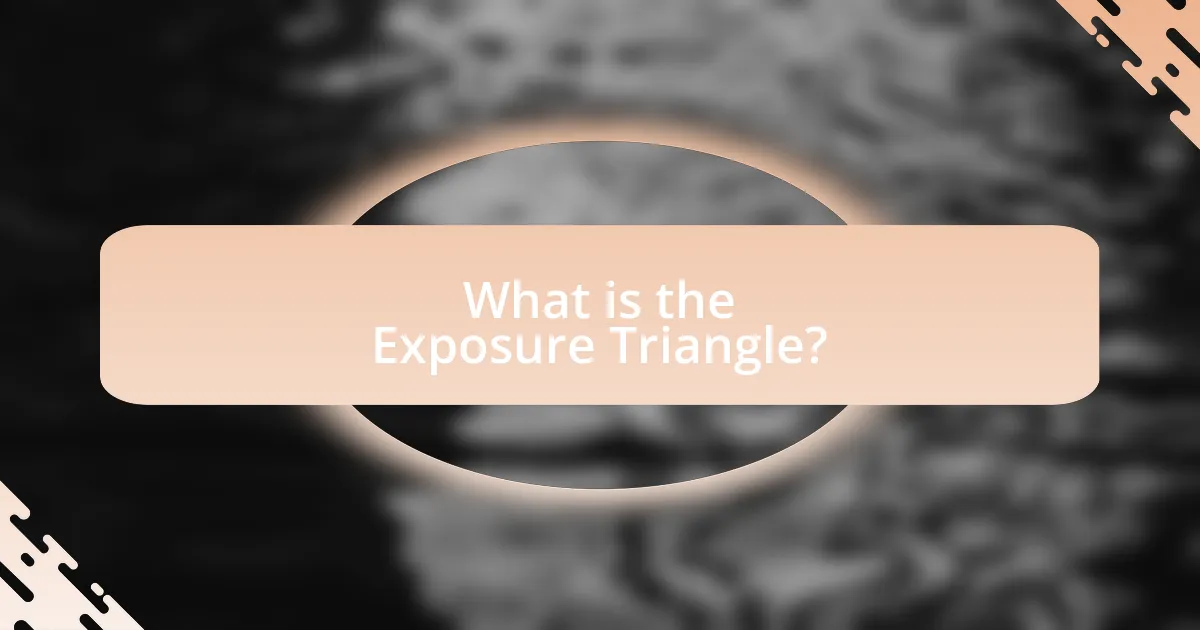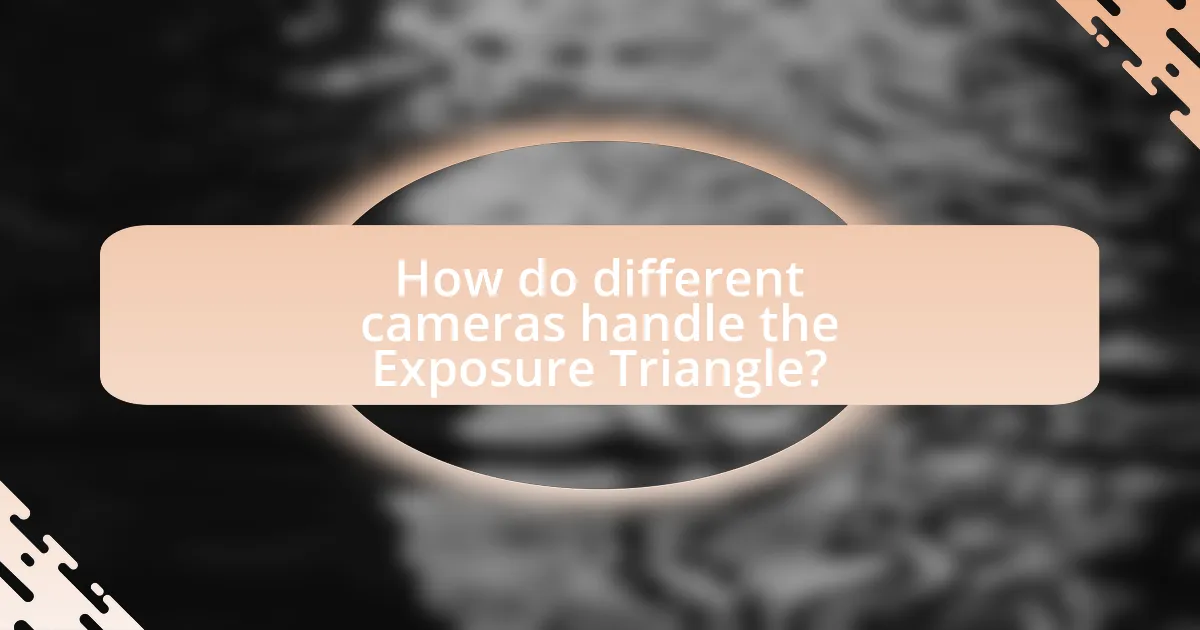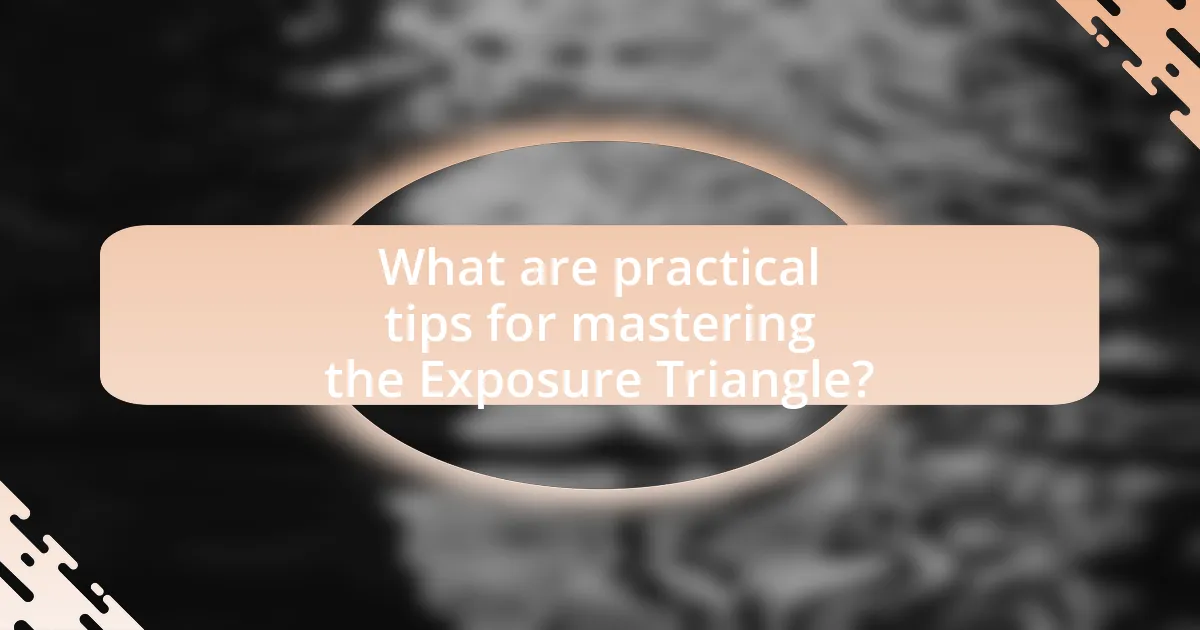The article focuses on mastering the Exposure Triangle, a crucial concept in photography that encompasses aperture, shutter speed, and ISO. It explains how these three elements interact to determine image exposure and quality, emphasizing the importance of balancing them for optimal results. The article also addresses common mistakes made by beginners, the significance of understanding exposure for camera buyers, and practical tips for improving exposure control. Additionally, it highlights the features to look for in cameras regarding exposure capabilities and offers resources for further learning on the subject.

What is the Exposure Triangle?
The Exposure Triangle is a fundamental concept in photography that describes the relationship between three key elements: aperture, shutter speed, and ISO. These three components work together to determine the exposure of an image, affecting its brightness and overall quality. Aperture controls the amount of light entering the camera, shutter speed dictates the duration of light exposure, and ISO measures the camera sensor’s sensitivity to light. Understanding how to balance these elements allows photographers to achieve the desired exposure and creative effects in their images.
How do the three components of the Exposure Triangle interact?
The three components of the Exposure Triangle—aperture, shutter speed, and ISO—interact by balancing exposure in photography. Aperture controls the amount of light entering the camera, shutter speed determines the duration of light exposure, and ISO adjusts the camera’s sensitivity to light. When one component is altered, the other two must be adjusted to maintain the same exposure level. For example, if the aperture is widened to allow more light, the shutter speed may need to be increased to reduce exposure time, or the ISO may need to be lowered to prevent overexposure. This interdependence ensures that photographers can achieve the desired exposure while also influencing depth of field and motion blur.
What are the roles of aperture, shutter speed, and ISO in photography?
Aperture, shutter speed, and ISO are the three fundamental components of the exposure triangle in photography, each playing a crucial role in determining the exposure and overall quality of an image. Aperture controls the amount of light entering the camera through the lens, affecting depth of field; a wider aperture (lower f-number) allows more light and creates a shallow depth of field, while a narrower aperture (higher f-number) reduces light and increases depth of field. Shutter speed determines the duration the camera’s sensor is exposed to light; faster shutter speeds freeze motion, while slower speeds can create motion blur. ISO measures the sensor’s sensitivity to light; a higher ISO allows for better performance in low-light conditions but can introduce noise, while a lower ISO results in cleaner images but requires more light. Together, these elements must be balanced to achieve the desired exposure and artistic effect in photography.
How does changing one component affect the others?
Changing one component of the exposure triangle—aperture, shutter speed, or ISO—directly impacts the other components and the overall exposure of an image. For instance, increasing the aperture (lower f-stop number) allows more light to enter the camera, which may require a faster shutter speed or lower ISO to prevent overexposure. Conversely, if the shutter speed is slowed down to capture more light, the aperture may need to be decreased or the ISO increased to maintain proper exposure. This interdependence is crucial for achieving the desired exposure and creative effect in photography, as each component must be adjusted in relation to the others to maintain balance.
Why is mastering the Exposure Triangle essential for camera buyers?
Mastering the Exposure Triangle is essential for camera buyers because it directly influences the quality of photographs they can achieve. The Exposure Triangle consists of three key elements: aperture, shutter speed, and ISO, which collectively determine exposure and image characteristics. Understanding how to balance these elements allows buyers to make informed decisions about camera settings, leading to better control over depth of field, motion blur, and noise levels in images. This knowledge is crucial for selecting a camera that meets their specific photographic needs and for maximizing the potential of their equipment.
How does understanding exposure improve photographic outcomes?
Understanding exposure significantly improves photographic outcomes by allowing photographers to control the interplay between aperture, shutter speed, and ISO, which are the three components of the exposure triangle. Mastery of these elements enables photographers to achieve the desired brightness, depth of field, and motion blur in their images. For instance, a well-exposed photograph captures details in both highlights and shadows, enhancing overall image quality. Studies have shown that images with optimal exposure are more visually appealing and engaging, leading to higher viewer satisfaction and retention.
What common mistakes do beginners make regarding exposure?
Beginners commonly make mistakes such as misunderstanding the relationship between aperture, shutter speed, and ISO, which are the three components of exposure. This lack of understanding often leads to overexposed or underexposed images. For instance, beginners may set a high ISO to compensate for low light without realizing it introduces noise, or they might use a fast shutter speed in bright conditions, resulting in dark images. Additionally, many beginners neglect to consider the impact of aperture on depth of field, which can affect the overall composition of their photos. These mistakes stem from a fundamental misunderstanding of how each element of the exposure triangle interacts with the others, leading to suboptimal photographic results.

How do different cameras handle the Exposure Triangle?
Different cameras handle the Exposure Triangle—comprising aperture, shutter speed, and ISO—through varying degrees of manual control and automation. DSLRs and mirrorless cameras typically offer full manual settings, allowing photographers to adjust each element independently for precise exposure control. In contrast, compact cameras and smartphones often rely on automatic settings, where the camera selects exposure parameters based on scene analysis, limiting user intervention. Advanced models may include semi-automatic modes, such as aperture priority or shutter priority, enabling users to control one aspect while the camera adjusts the others. This flexibility in handling the Exposure Triangle is crucial for achieving desired photographic outcomes, as evidenced by the varying capabilities across different camera types.
What features should camera buyers look for related to exposure?
Camera buyers should look for features such as adjustable ISO settings, aperture control, and shutter speed options to effectively manage exposure. Adjustable ISO allows users to control the camera’s sensitivity to light, which is crucial for capturing images in varying lighting conditions. Aperture control enables the adjustment of the lens opening, influencing both exposure and depth of field. Shutter speed options determine how long the camera’s sensor is exposed to light, affecting motion blur and overall image brightness. These features collectively empower users to achieve the desired exposure in their photography.
How do manual and automatic modes affect exposure control?
Manual and automatic modes significantly influence exposure control in photography. In manual mode, the photographer has complete control over aperture, shutter speed, and ISO settings, allowing for precise adjustments to achieve the desired exposure based on specific lighting conditions. This level of control enables creative decisions, such as achieving a shallow depth of field or capturing motion blur.
In contrast, automatic mode relies on the camera’s algorithms to determine exposure settings, which can lead to inconsistent results in varying lighting situations. The camera evaluates the scene and makes adjustments, but it may not always align with the photographer’s artistic intent. For example, automatic mode might overexpose a bright scene or underexpose a dark one, as it lacks the nuanced understanding that a photographer might have.
Thus, manual mode offers greater flexibility and accuracy in exposure control, while automatic mode provides convenience but may compromise creative expression.
What are the advantages of cameras with advanced exposure settings?
Cameras with advanced exposure settings offer greater control over image quality and creative expression. These settings allow photographers to manipulate aperture, shutter speed, and ISO independently, enabling them to achieve desired effects such as depth of field and motion blur. For instance, a photographer can use a wide aperture to create a shallow depth of field, isolating the subject from the background, or a slow shutter speed to capture motion in a dynamic way. This level of control is essential for adapting to various lighting conditions and achieving professional-quality results, as evidenced by studies showing that advanced settings can significantly enhance the overall aesthetic of photographs.
How can camera buyers assess their needs regarding exposure?
Camera buyers can assess their needs regarding exposure by understanding the exposure triangle, which consists of aperture, shutter speed, and ISO. Each component affects the final image quality and exposure level; for instance, a larger aperture allows more light, while a faster shutter speed reduces motion blur. Buyers should evaluate their shooting conditions, such as lighting environments and subjects, to determine which settings will best suit their photography style. For example, low-light conditions may require a higher ISO or wider aperture to achieve proper exposure. Understanding these factors enables buyers to select a camera that aligns with their specific exposure requirements, ensuring they can capture images effectively in various scenarios.
What types of photography require specific exposure considerations?
Types of photography that require specific exposure considerations include landscape, portrait, macro, and night photography. Landscape photography often demands careful exposure settings to capture the dynamic range of light in natural scenes, particularly during sunrise or sunset. Portrait photography requires specific exposure adjustments to ensure skin tones are accurately represented, often utilizing techniques like backlighting or fill flash. Macro photography necessitates precise exposure settings due to the shallow depth of field and the close proximity to the subject, which can lead to significant variations in light. Night photography requires longer exposure times to capture low-light scenes effectively, often using tripods to prevent motion blur. Each of these photography types has unique lighting challenges that necessitate tailored exposure settings for optimal results.
How does one determine the right camera based on exposure capabilities?
To determine the right camera based on exposure capabilities, one should evaluate the camera’s ISO range, aperture settings, and shutter speed options. Cameras with a wider ISO range allow for better performance in low-light conditions, while lenses with larger apertures (lower f-stop numbers) enable more light to enter, enhancing exposure flexibility. Additionally, cameras that offer a variety of shutter speed settings provide greater control over motion blur and exposure duration. For instance, DSLRs and mirrorless cameras typically have superior exposure capabilities compared to compact cameras, as they allow for manual adjustments and have advanced metering systems.

What are practical tips for mastering the Exposure Triangle?
To master the Exposure Triangle, focus on understanding the relationship between aperture, shutter speed, and ISO. Start by practicing with manual mode on your camera, allowing you to adjust each element independently. Experiment with different aperture settings to see how they affect depth of field; wider apertures (lower f-stop numbers) create a shallow depth of field, while narrower apertures (higher f-stop numbers) increase depth of field. Adjust shutter speed to control motion blur; faster speeds freeze action, while slower speeds can create motion blur for artistic effects. Finally, manipulate ISO to manage sensitivity to light; higher ISO settings allow for shooting in low light but can introduce noise. Regularly reviewing your images and adjusting settings based on the results will reinforce your understanding of how these three elements interact, ultimately leading to better exposure control in your photography.
How can beginners practice using the Exposure Triangle effectively?
Beginners can practice using the Exposure Triangle effectively by experimenting with different combinations of aperture, shutter speed, and ISO settings in various lighting conditions. This hands-on approach allows beginners to see how each element affects exposure and image quality. For instance, using a low aperture (like f/2.8) in bright light can create a shallow depth of field, while a high shutter speed (like 1/1000s) can freeze motion. By taking multiple shots with varying settings, beginners can learn to balance these three components to achieve the desired exposure and artistic effect. This method is supported by photography education resources, which emphasize practical experimentation as a key learning strategy.
What exercises can help improve understanding of exposure settings?
To improve understanding of exposure settings, photographers can engage in practical exercises such as the “Exposure Triangle Challenge,” where they manually adjust aperture, shutter speed, and ISO while capturing the same scene to observe the effects on exposure and depth of field. This hands-on approach reinforces the relationship between these settings, allowing users to see how changes impact the final image. Additionally, using a light meter to measure light in various conditions can enhance comprehension of how exposure settings interact with different lighting scenarios. These exercises are effective because they provide real-time feedback, enabling photographers to internalize the principles of exposure through direct experience.
How can one use exposure compensation to enhance images?
Exposure compensation can be used to enhance images by adjusting the exposure level to either brighten or darken the photograph based on the desired outcome. This adjustment allows photographers to correct for situations where the camera’s automatic settings may misinterpret the scene’s lighting, such as backlighting or high-contrast environments. For instance, increasing exposure compensation by one or two stops can help illuminate subjects in shadow, while decreasing it can prevent overexposure in bright scenes. This technique is particularly effective in achieving the intended mood and detail in images, as it directly influences the final brightness and contrast.
What resources are available for further learning about the Exposure Triangle?
Comprehensive resources for further learning about the Exposure Triangle include online courses, photography books, and instructional videos. Websites like Coursera and Udemy offer structured courses that cover the fundamentals of exposure, including aperture, shutter speed, and ISO. Notable books such as “Understanding Exposure” by Bryan Peterson provide in-depth explanations and practical examples. Additionally, platforms like YouTube host numerous tutorials from experienced photographers that visually demonstrate the concepts of the Exposure Triangle, making it easier for learners to grasp the material.
Which online courses or tutorials are recommended for mastering exposure?
Recommended online courses for mastering exposure include “Photography Masterclass: A Complete Guide to Photography” on Udemy, which covers exposure in-depth, and “Fundamentals of Photography” by the Great Courses, focusing on the exposure triangle. These courses provide structured learning and practical exercises to enhance understanding of exposure settings. Additionally, the “Exposure Triangle” tutorial on YouTube by Tony & Chelsea Northrup offers visual explanations and real-world examples, reinforcing concepts effectively.
What books provide in-depth knowledge about the Exposure Triangle?
Books that provide in-depth knowledge about the Exposure Triangle include “Understanding Exposure” by Bryan Peterson, which thoroughly explains the relationship between aperture, shutter speed, and ISO. Another notable book is “The Digital Photography Book” by Scott Kelby, which offers practical insights into exposure settings in various shooting scenarios. Additionally, “The Photographer’s Eye” by Michael Freeman delves into composition and exposure, providing a comprehensive understanding of how these elements interact. These books are widely recognized in the photography community for their clarity and depth on the subject.
What are common troubleshooting tips for exposure-related issues?
Common troubleshooting tips for exposure-related issues include adjusting the aperture, shutter speed, and ISO settings to achieve the desired exposure. For instance, if images are too dark, increasing the ISO or opening the aperture can allow more light to hit the sensor. Conversely, if images are overexposed, reducing the ISO or closing the aperture can help. Additionally, using exposure compensation can fine-tune the exposure level without altering the camera settings drastically. These adjustments are essential for achieving balanced exposure, as improper settings can lead to underexposed or overexposed images, impacting overall image quality.